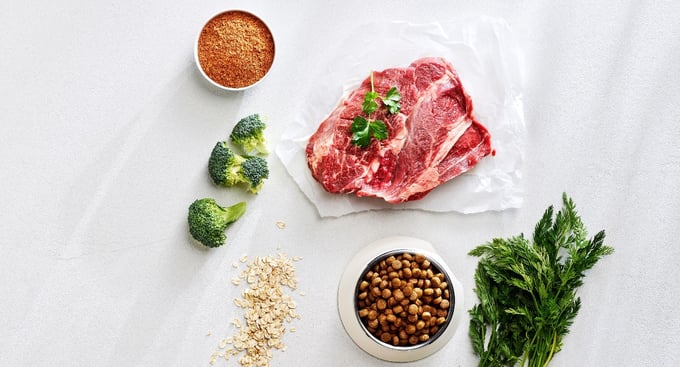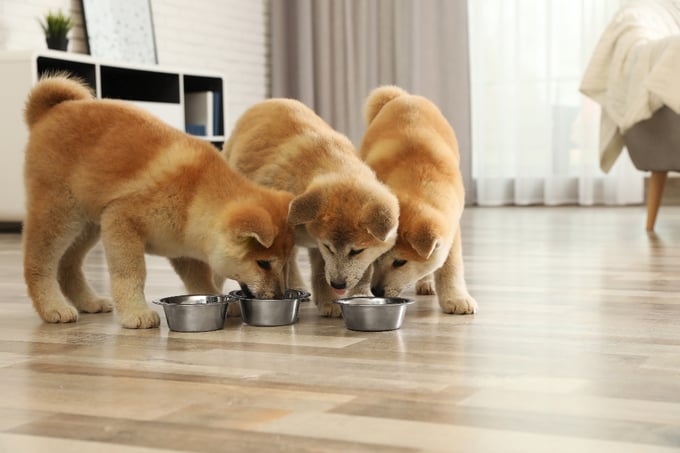Tonje Dominguez is our Director of QRILL Specialty Animal Nutrition Products. She has been working for more than 22 years in the pet food industry, has three lovely dogs, and knows everything about how to make pet food and treats taste best. The next article, written by Tonje, explains what makes cats and dogs prefer a pet food over another.

Developing and producing good pet food demands a high degree of knowledge from pet food producers. Not only should the food be of high nutritional quality, but it must also be palatable for the pet.
This balance is not always easy, especially when designing specialty food that requires a specific nutrient profile. With pets, as with humans, it’s not always about what you like best, it’s what is best for your body too.
Palatability is complex and is more than just about taste. Palatability is defined as the pet’s individual subjective preference for taste, odor, and texture or mouthfeel. And the difference in palatability preferences between cats and dogs is clear: cats and dogs do not necessarily like the same food. So, let's have a look at these differences.
"The difference in palatability preferences between cats and dogs is clear - they don't necessarily like the same food."
Nutrient preference
Dogs are omnivores (even though they belong to the Carnivora order), meaning they are naturally able to eat and survive on both plant and animal nutrients. However, being descendants of ancient wolves, they still prefer meat-based diets over cereal-based ones.
Cats are obligated carnivores, meaning they are only able to survive if a sufficient part of their diet is derived from animal nutrients, and these several nutrients can only be found in large enough quantities in animal tissue. Consequently, cats also prefer meat-based diets.
Looking at the nutrient preference of the two species shows that dogs tend to prefer high-fat diets, while cats prefer high-protein diets (1,2,3).

Importance of odor
Both cats and dogs are very dependent on smell and much more sensitive to odor than humans. And although dogs have more than twice the amount of olfactive (smell) neurons as cats and a larger part of the brain is dedicated to odor (10% in dogs, 6% in cats) (4), cats are still very dependent on the odor to make a food choice, probably due to their weaker ability to taste.
In palatability tests, several food choices can be presented to pets at once. In such tests, it is seen that cats spend time sniffing and evaluating palatability, taking small bites of food up to the roof of the mouth where a sensitive smell organ (Jacobson's organ) is located before they choose what to eat. And when finally chosen, they can just as easily change their minds and try a different food.
Dogs, on the other hand, tend to sniff, choose, and eat rapidly. And when the food choice is made, they tend to stick to it.
Taste preference
Dogs have 1600 taste buds in the mouth cavity and just like humans and other omnivores, they can detect 5 basic tastes: sour, bitter, salty, sweet and umami (meaty flavor). They tend to like the sweet taste and umami the best.
Cats, being true carnivores, are different from dogs and have weaker taste abilities. They have only 473 taste buds and detect 4 basic tastes: sour, bitter, salty and umami. Cats are not able to sense the 5th taste, sweetness, due to a genetic defect (in the Tas1r2 gene that codes for sweet taste receptors) often seen in strictly meat-eating species (5).
In general, they are drawn to amino acids as that has the most abundant taste bud in cats that responds to the umami taste. Furthermore, they tend to avoid strong sour taste (6) and seem unresponsive to salt as a palatability enhancer in cat food.
Both cats and dogs seem to be reluctant to bitterness, and they can perceive this taste much better than humans. It is anticipated that their resistance is due to a positive relation between bitterness and toxicity in food and that pets, therefore, can reject bitterness to avoid food poisoning (7).

Texture, a complex parameter
The texture is a complex parameter that includes fracturability, hardness, resilience, and chewiness, and all are dependent on the ingredient combination and production process when making pet food.
Cats are generally pickier on texture and mouth feel than dogs, and crunch and low-density easy-to-break pieces are appreciated in dry food since they don't have jaw movements for grinding kibbles.
Both cats and dogs prefer moist food at room temperature (or slightly higher) over dry food since this form will release a stronger odor and taste they highly appreciate.
Even though there is much more to say about pets and palatability, these are the most important factors. However, there is one last factor worth mentioning: the human factor.
If a pet signals to an owner that the food is not to his or her liking, the owner tends not to re-purchase the same food again. Hence, excellent palatability is extremely important in pet food production so that both the pet willingly eats it, and the owner perceives that the pet enjoys it.
References
- Hewson-Hughes, A. K., Hewson-Hughes, V. L., Miller, A. T., Hall, S. R., Simpson, S. J. and Raubenheimer, D. (2011). Geometric analysis of macronutrient selection in the adult domestic cat, Felis catus. J. Exp. Biol. 214, 1039-1051.
- Hewson-Hughes, A. K., Hewson-Hughes, V. L., Colyer, A., Miller, A. T., McGrane, S. J., Hall, S. R., Butterwick, R. F., Simpson, S. J. and Raubenheimer, D. (2013). Geometric analysis of macronutrient selection in breeds of the domestic dog, Canis lupus familiaris. Behav. Ecol. 24, 293-304.
- Jean A. Hall1,*, Jodi C. Vondran2, Melissa A. Vanchina2 and Dennis E. Jewell2. When fed foods with similar palatability, healthy adult dogs and cats choose different macronutrient compositions. Journal of Experimental Biology (2018) 221, jeb173450. doi:10.1242/jeb.173450
- Diana Pet Food, article in Pet Food Processing, online version, 2020.
- Jiang P, Josue J, Li X, Glaser D, Li W, Brand JG, Margolskee RF, Reed DR, Beauchamp GK. Major taste loss in carnivorous mammals. Proc Natl Acad Sci U S A. 2012 Mar 27;109(13):4956-61. doi: 10.1073/pnas.1118360109. Epub 2012 Mar 12. PMID: 22411809; PMCID: PMC3324019.
- Association for Chemoreception Sciences (AChemS), 38th Annual Meeting, April 20–23, 2016, Bonita Springs, Florida. Chemical Senses41, e1-e110, doi:10.1093/chemse/bjw085 (2016)
- John I. Glendinning “Is the bitter rejection response always adaptive?” Physiology & Behavior, Volume 56, Issue 6, 1994, Pages 1217-1227, ISSN 0031-9384, https://doi.org/10.1016/0031-9384(94)90369-7.
Functional Marine Ingredients from Antarctic Krill

